The Cartoon Museum in London, formerly in Little Russell Street, will re-open shortly in new premises at 55 Wells Street, near Oxford Circus. There is no equivalent in Dublin.
We have, however, a rich history of cartooning in Ireland, and it fits comfortably into what Vivian Mercier called the “Irish comic tradition” – which, he argued, is the central tradition of Irish and Anglo-Irish literature and can be traced back to oral Gaelic roots in the ninth century.
He identified the elements of this tradition as “a bent for wild humour, a delight in witty word play and a tendency to regard satire as one of the indispensable functions of the literary man”.
During the Civil War, the republican publicity effort was strengthened by the services of two talented women cartoonists, Constance Markievicz and Grace Gifford
One of the earliest satirical cartoons in Ireland appeared in Mathew Carey’s Volunteers’ Journal on April 5th, 1784. Entitled “Thus perish all traitors to their country”, it shows John Foster, then chancellor of the exchequer in the Irish Parliament at College Green, hanging from a gibbet.
Carey was arraigned before the Irish House of Commons on account of this cartoon and was jailed in Newgate prison in Dublin. On his release, he fled to America and had a highly successful career as a publisher in Philadelphia.
During the first half of the nineteenth century, Daniel O’Connell was the focus of innumerable cartoons produced in Dublin and in London – most of them hostile and savagely anti-Catholic. The most notable caricaturist of this period was a Catholic Irishman, John Doyle – who, however, plied his trade exclusively in London.
As Professor Peter Gray has pointed out, Doyle was “preoccupied with Daniel O’Connell . . . whose career after 1829 appeared to Doyle to embody a demagogic combination of radicalism, nationalism and Catholic grievance politics”.
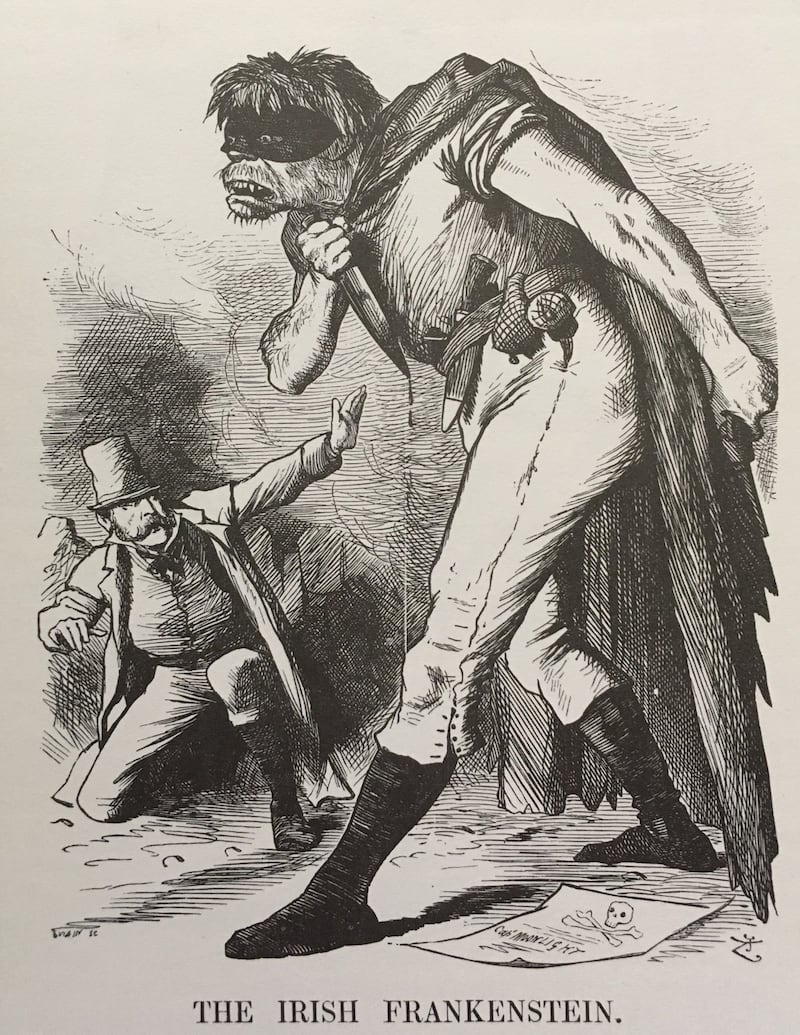
‘Siminianisation’ of the Irish
“The O’Connell Rent” by John Leech, published in Punch in 1845, is a good example of an anti-O’Connell cartoon. It refers to the subscriptions raised for O’Connell’s Repeal Association. The main image is of abject and deferential peasants paying the so-called rent to the great man. It is a crude caricature – but redeemed by the whimsical drawings of incidents in O’Connell’s life that appear in the margins.
The lower margin focuses on the trial of O’Connell and others in 1844 for conspiracy: O’Connell in the dock, the judges opposite him, and in between an incident involving duelling pistols – a not-too-subtle allusion to the duel in 1815 in which O’Connell killed D’Esterre.
Leech and other Punch cartoonists, notably Henry Furniss and John Tenniel, are notorious today for their “siminianisation” of the Irish. Professor Perry Curtis wrote about “the steady stream of derogatory or denigrating stereotypes emanating from London - mostly vividly expressed by the cartoonists’ transformation of militant Irish nationalists, especially Fenian or republican rebels, into apelike or bestial creatures”.
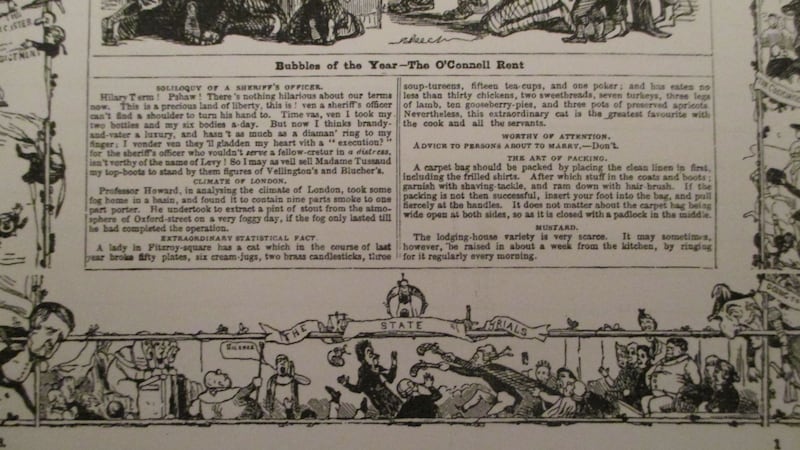
Tenniel’s particularly loathsome “Irish Frankenstein” appeared in Punch shortly after the Phoenix Park murders in 1882. Leech was of Irish extraction, and Furniss was born in Wexford – of English parents – and began his career with the Irish satirical magazine, Zozimus.
There were many satirical magazines in Dublin in the late 19th century, but none had as much impact or lasting significance as the cartoons published by the Weekly Freeman, beginning in 1880. Introducing a satirical note into the mainstream press in Ireland for the first time, these cartoons were distributed gratis as supplements with the newspaper.
They addressed political themes with great immediacy, and the fact that they were in colour added to their appeal. They were duly copied by other Irish newspapers, such as United Ireland and the Weekly Irish Times. These cartoons are a uniquely Irish phenomenon, with no exact parallel in the British press. The three artists mainly responsible for them were John D Reigh, Thomas Fitzpatrick and John Fergus O’Hea.
O’Hea’s cartoon “What villains have done this?”, published by the Freeman in response to the Phoenix Park murders, is in stark contrast to Tenniel’s “Irish Frankenstein” and features the female figure of Erin. Curtis observed that “although the iconic figure of Erin or Hibernia has a long history, the golden age of graphic images of this beautiful, young and virtuous epitome of Ireland really belongs to the last third of the nineteenth century”. Erin appears in about one-third of the cartoons published by the Weekly Freeman and United Ireland.
We made no enemies and our victims became our friends
Fitzpatrick and O’Hea later collaborated on a monthly satirical magazine called The Lepracaun, published in Dublin between 1905 and 1915. By then, their style of cartooning had become dated. A more subtle and crisper kind of cartoon was appearing in London newspapers such as the Daily Mail and Daily Mirror – a by-product of the so-called “Northcliffe revolution” which created the modern mass-circulation, populist press.
This new form of cartooning came to Ireland with the recruitment of an Englishman, Ernest Forbes, to the staff of the Freeman’s Journal in 1920. Using the pseudonym “Shemus”, he was the first regular cartoonist on an Irish daily newspaper.
His cartoons during the War of Independence and Civil War were daring and hard-hitting: up to the Truce in 1921, their main target was the increasingly brutal nature of British rule in Ireland, while afterwards they attacked the new government of Northern Ireland and the die-hard republican forces challenging the writ of the new Irish Free State.
During the Civil War, the republican publicity effort was strengthened by the services of two talented women cartoonists, Constance Markievicz and Grace Gifford (widow of Joseph Mary Plunkett). Their cartoons were important because few print outlets available to the republicans had the capacity to include photographs, and cartoons were a tolerable substitute.
Isa Macnie (“Mac”) is only other Irish woman cartoonist of note; a selection of her caricatures of members of the government of the Free State was published in 1925 as The Celebrity Zoo.
In March 1922, as Ireland drifted towards civil war, two young men – Arthur Booth and Charles E Kelly, both Dubliners and both gifted cartoonists – launched Dublin Opinion, a monthly miscellany of cartoons and other humorous features.
They were joined by Tom Collins, another Dubliner, as the principal writer. The first issue sold out, and that was the start of a successful run that went on until 1968. Its light tone at a time of great political upheaval seemed to catch the public imagination.
It claimed not to have any politics, but instead to be on the side of the people and against whatever government was in power. Its policy was to give only kindly criticism – which meant that, as Kelly wrote, “we made no enemies and our victims became our friends”.
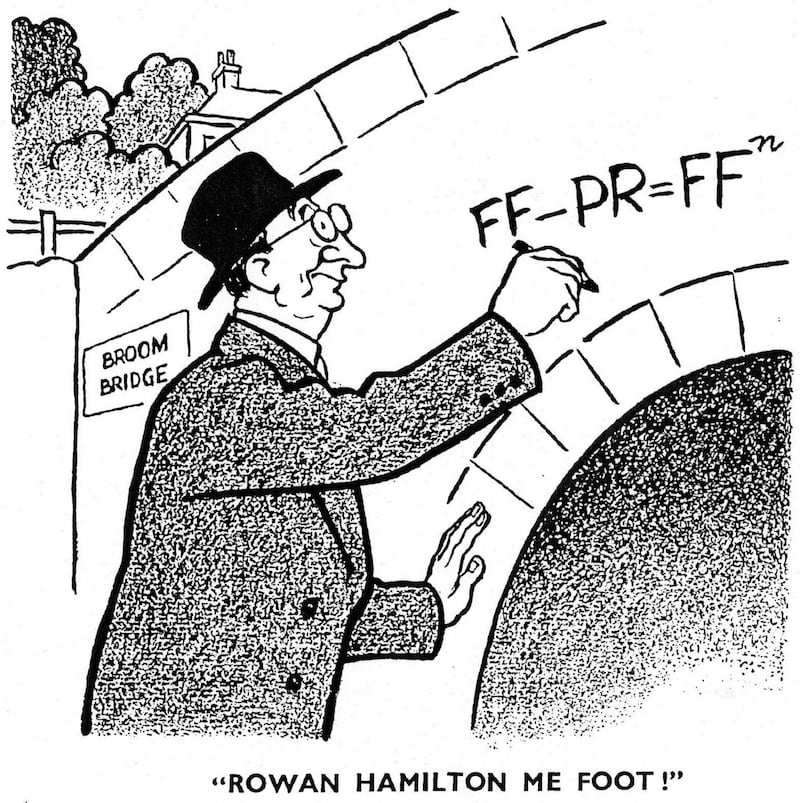
Cartoon monopoly
It did not always, however, exercise such restraint – as when in 1959 it stoutly defended Proportional Representation (PR), which Éamon de Valera and the Fianna Fáil government sought to abolish.
Two of its cartoons at that time were brilliantly incisive. The first, capitalising on de Valera’s reputation as a mathematics genius, has him standing at Broom Bridge in Dublin – associated with Rowan Hamilton’s discovery of the formula for quaternion multiplication – and chalking up on the side of the bridge this formula: FF - PR = FFn.
The second shows a schoolroom with three boys of different heights at a blackboard on which their teacher has drawn three apples, and the teacher explains: “Under PR, each boy gets an apple; under the ‘straight vote’, the biggest boy gets the lot”. The referendum necessary to abolish PR was lost by a narrow margin, and Dublin Opinion’s campaign was widely credited with having had a critical influence on the outcome.
Dublin Opinion virtually monopolised cartooning in Ireland during its years of publication. When the Freeman’s Journal went out of business in 1924, Ernest Forbes returned to England – and, except for the work of Gordon Brewster in the Evening Herald and Sunday Independent, and of Victor Brown (“Bee”) in the early years of the Irish Press, the satirical cartoon was thereafter largely absent from Irish newspapers until the 1970s.
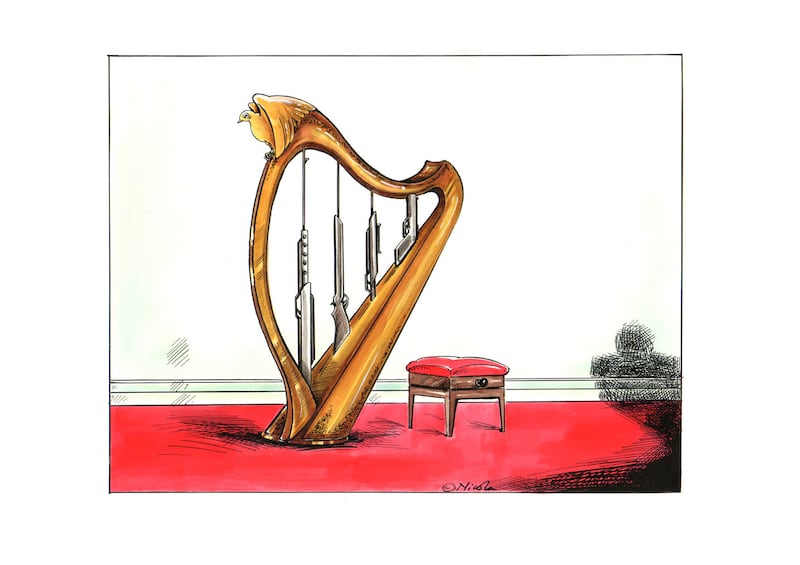
Brewster’s cartoons mostly eschewed Irish politics, focusing instead on lifestyle and socio-economic matters. Brown, like Forbes, was English – and, since the Press was the party organ of Fianna Fáil, his cartoons were often blatantly partisan.
After Irish independence in 1922, British cartoonists largely ignored Ireland and the Irish until the Troubles in Northern Ireland broke out in the late 1960s and the IRA later extended its campaign of violence to Britain. Their response, especially in the tabloid press, was to resurrect and repackage the image of the simian Irish from the pages of Punch a century earlier.
Unlike in the Victorian era, such anti-Irish stereotypes now embraced the Protestant as well as the Catholic Irish. Raymond Jackson (‘JAK’) published a cartoon in the Evening Standard in 1982 depicting a spoof film poster for “The ultimate in psychopathic horror: the Irish”, with terrorists on both sides of the Troubles as equally misshapen monsters comparable to those depicted in Tenniel’s cartoon.
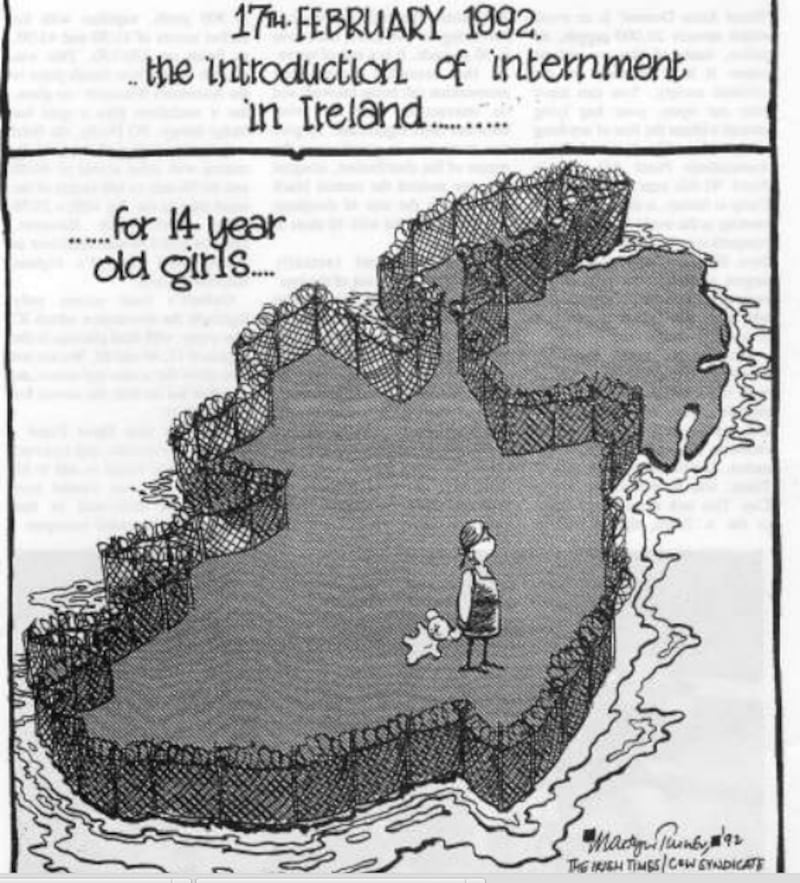
‘Harp and Guns’
Some British cartoons, however, displayed a more sophisticated perspective on the Troubles. One such is Nicola Jennings’ “Harp and Guns”, in which the strings of the symbolic Irish harp are replaced with guns and “the shadow of a gunman” heaves into view, a genuflection towards Seán O’Casey’s play. Instead of the winged maiden on the harp, there is a dove – acknowledgement of an aspiration to peace despite the violence endemic in Ireland.
After Dublin Opinion ceased publication in 1968, there was no successor magazine – but the vacuum was filled when Martyn Turner was employed by the Irish Times as its first full-time cartoonist in 1976. In the words of Terence Brown, his “politically acute cartoons . . . add to the newspaper’s reputation for sharply expressed and hard-hitting commentary”.
Turner’s greatest cartoon to date is that published on February 17th, 1992 regarding the Irish government’s efforts to prevent a pregnant 14-year-old girl from travelling to England for an abortion.
His depiction of the young girl, with her hair in a pigtail and carrying a teddy bear, standing on a map of Ireland and surrounded by a fence topped with razor wire has left an indelible mark on public discourse in Ireland about the abortion issue.
Cartoons matter, which is why we in Ireland should have a museum – or at least a gallery within a museum or library – to honour the quirky craft of our cartoonists.



















